There’s a saying that artworks either look good from 30 feet away, or from three feet away. This is true of the works of both Kehinde Wiley and David McGee. Wiley makes crisp, splendid billboards with no intimacy, no pleasure to be had up close. McGee also works well at large scale, but where he really shines is in his small works on paper, which read like the witty, haunting pages from the illuminated manuscript of a book lover.
Wiley is an international superstar, with studios on three continents staffed with assistants who execute much of his work. He has had more than three dozen solo shows at museums and biennials throughout the world, including Kehinde Wiley: An Architecture of Silence, a traveling show that will arrive at the Museum of Fine Arts, Houston on November 19.
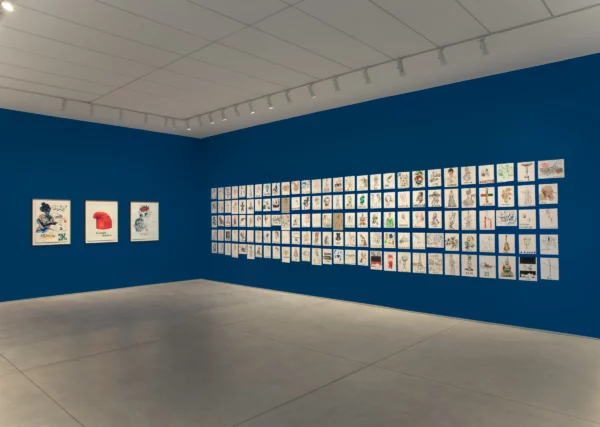
Installation view of “David McGee: The Tarot Cards and The Gloria Paintings” at Inman Gallery. Photo: Allyson Huntsman/Inman Gallery
McGee has lived in Houston for about 40 years. He has had fewer than ten solo museum shows in his career, some at Texas institutions, including The Menil Collection and the Contemporary Arts Museum Houston (CAMH). His current show at Inman Gallery, The Tarot Cards and The Gloria Paintings, is on view through November 1.
Both artists are African American male painters whose work involves combining Black men and women with art historical references, including explicitly placing a Black figure within a famous painting. (Both artists have referenced Jacques-Louis David in major works: McGee’s 1996 oil painting Lush Life is based on David’s The Death of Marat, and Wiley’s 2006 oil painting Napoleon Leading the Army over the Alps references David’s Bonaparte Crossing the Alps.)
In short, these two artists, both of whom have shows this fall in Houston, are working with the same basic idea. McGee just does it much better.
For one thing, McGee makes his own work, whereas Wiley uses a graphic designer, specialist painters, and 3-D imaging assistants to make his. There are lots of highfaluting arguments about why this doesn’t matter. But setting aside the idea that an artist’s individual craftsmanship is inconsequential — setting aside the workshops of Leonardo da Vinci and Damien Hirst — if I were a collector buying paintings, I would only want things the artist actually produced.
Regardless of who painted them, McGee’s finished works are far more interesting, both on their surface and in their ideas. And this latest show is the best work of his I’ve seen in over 25 years of looking at it. Now in his early 60s, McGee has taken watercolor, his strongest medium, to the next level.
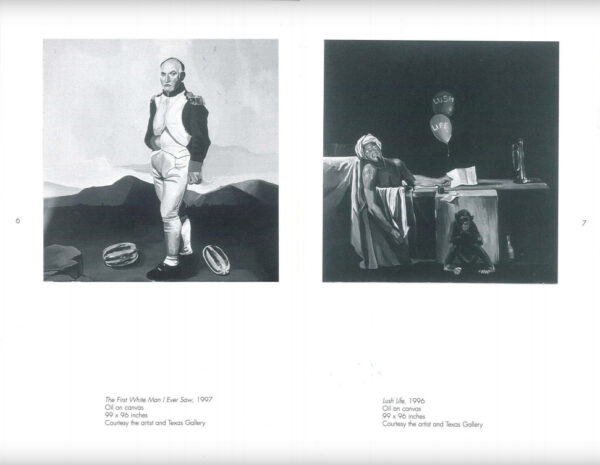
A black and white spread from the catalog for “David McGee: Black Comedies and Night Music” at the CAMH
This show is similar to his 1998 exhibition, Black Comedies and Night Music, at the CAMH, with large portraits of Black figures in period dress alongside a grid of small works that combine text and imagery. The former read from 30 feet; the latter read from three. And these smaller works on paper, the “tarot cards” referenced in the title at Inman Gallery, are where things really get interesting.
Each is a succinct, elegant vignette packed with subtext about how race has played out in Western culture. Each draws on multiple sources from art history, literature, religion, history, and pop culture. McGee loves and respects the traditional canon, even as he undercuts it with his running commentary on the farcical way that canon has been organized according to skin color. With humor, with beauty, and with bitter anger, he reaches into the canon’s treasure chest and holds up what he finds for close examination.
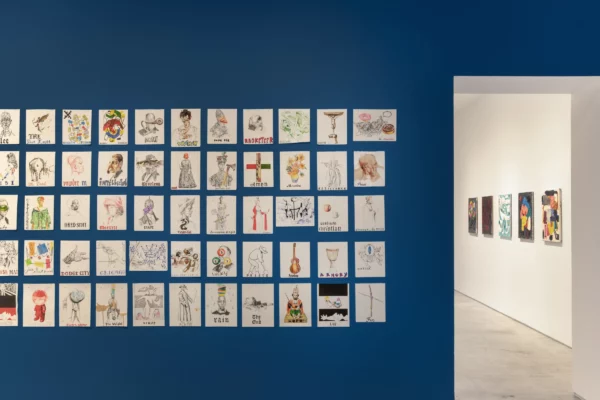
Installation view of “David McGee: The Tarot Cards and The Gloria Paintings” at Inman Gallery. Photo: Allyson Huntsman/Inman Gallery
McGee compares the tarot cards to automatic writing, saying that while he was making them (from 2017 to 2022) he was trying to capture whatever emerged from his subconscious. He says their “push and pull” of past and present — imagery and text taken both from history and from contemporary culture — is inspired by epic poems like The Odyssey and Derek Walcott’s Omeros, era-spanning stories in which the protagonist is trying to go home.
Each one pairs an image with a word or phrase. Text is critical to these works; McGee says that he was trying to “dislocate” image and text by “seeing how they can be put off kilter by the pairing.” He hand-letters the fonts and carefully considers which one to use. He created a cartoonish one for the words “american psycho,” which are paired with a drawing based on a Philip Guston painting of two hooded KKK figures in a car. In some works he uses Gothic, script, block, and comic book fonts, while in others he uses fonts associated with the brands Coca-Cola and Pokemon.
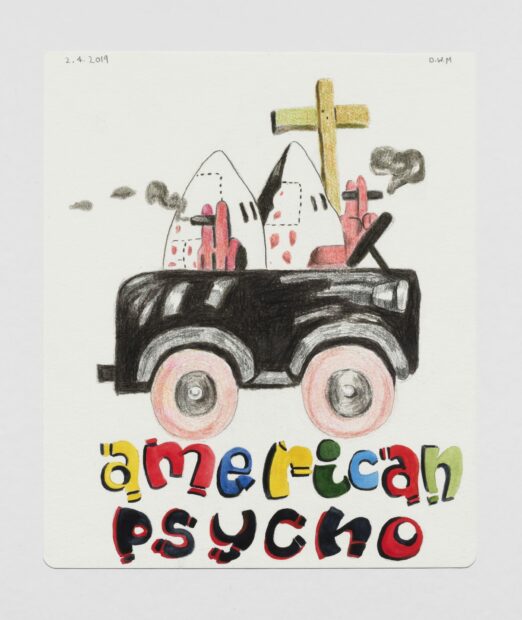
David McGee, “american psycho” from “The Tarot Cards Series,” 2019, watercolor on paper. Photo: Tom DuBrock/Inman Gallery
As for imagery, most of the tarot cards reference a famous artwork, sometimes old masters like Hans Holbein and Diego Velázquez, sometimes iconic works from the 20th century. Others are based on portraits ranging from Egon Schiele to photographs from the American Civil War.
Some of the pairings of image and text are straightforward: a cotton plant with the words “blood money”; a Jeff Koons chromed inflatable rabbit sculpture with the words “Gilded Age”; a Native American whose face is superimposed with the now-abandoned Washington Redskins logo and the words “LAST STAND” below. A drawing of a John Chamberlain crushed car sculpture is paired with “Henry Ford,” a man famously associated with cars who was also infamously a supporter of the KKK (an organization whose “ridiculous performative racism” McGee dismisses as “sheet shit”).

David McGee, “PSYCHO” from “The Tarot Cards Series,” 2019, colored pencil and watercolor on paper. Photo: Tom DuBrock/Inman Gallery
Other tarot cards reference multiple sources. Famous white people are drawn or painted with food on their faces or their heads, notably Alexander Hamilton with a bright orange popsicle in front of his face and the word “Sucker” below. A watercolor based on Théodore Géricault’s study for his painting The Raft of the Medusa is paired with “9th Ward,” a reference to the flooded Black neighborhood in New Orleans during Hurricane Katrina. A Picasso skull hovers above the words “DARK CONTINENT,” a reference to that artist’s reliance on African sculpture in many of his most iconic works. A watercolor sketch of people on a tightrope is paired with elegant script reading “Aide_De_Camp,” which McGee says represents democracy: a tightrope with no net.
Critically, some tarot cards feature Black women with weapons, including the servant from Édouard Manet’s Olympia, who holds flowers in one hand and a meat cleaver behind her back in the other. McGee describes these figures as “avenging angels” who appeared unbidden in his drawings and whose narratives he wanted to pursue in the larger works in the show.
And they are indeed narrative: for the larger portraits, prior to painting, McGee writes a script that includes dialogue and backstories for each figure. “This is kind of corny and strange and odd, but it’s the only way I can get into the people,” he says. “This is a method acting way of writing, so when I’m painting them, I know where they come from.” He says he has to make these “first thought, best thought” automatic writing scripts before he can paint a figure.
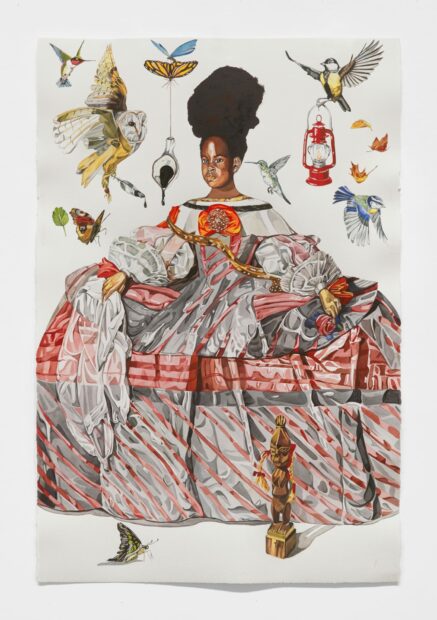
David McGee, “THE ANOINTED,” 2023, watercolor on 300lb watercolor paper. Photo: Allyson Huntsman/Inman Gallery
The show at Inman Gallery features three monumental watercolors of Black women and, in the entryway, one of a Black girl, which is based on the central princess from Velazquez’s masterpiece Las Meninas. These are the 30-foot works in the show: they feature McGee’s distinctive watercolor technique of painting horizontally, layering colors to achieve brilliant vibrancy. Up close, the images look almost pieced together — McGee says they are “quilted,” made of abstract shapes that resolve into a recognizable composition from a distance. (This technique works particularly well on the sumptuous fabrics of the figures’ dresses.) Packed with allegory, they include birds, insects, or other objects on an otherwise stark white background, which McGee says was in part inspired by Richard Avedon’s photographs from his project In the American West.

Installation view of “David McGee: The Tarot Cards and The Gloria Paintings” at Inman Gallery. Photo: Allyson Huntsman/Inman Gallery
McGee’s process is monotonous and labor-intensive, and he says the pre-painting scriptwriting helps alleviate the intense focus required to execute the large watercolors. It also helps set the composition in advance, as watercolor is a notoriously inflexible material that doesn’t allow for mistakes, especially at this “scary” scale, as McGee describes it.
Sadly for the purposes of direct comparison, Kehinde Wiley’s and McGee’s exhibits will not overlap this fall in Houston. But audiences who take the time to see both will experience the same basic idea, both in Wiley’s polished, repetitive form, and in McGee’s richly varied offerings. McGee is a cultural excavator, digging deep under the surface of who we are, where we came from, and where we can hope to go.
David McGee: The Tarot Cards and The Gloria Paintings is on view at Inman Gallery through November 1, 2023.


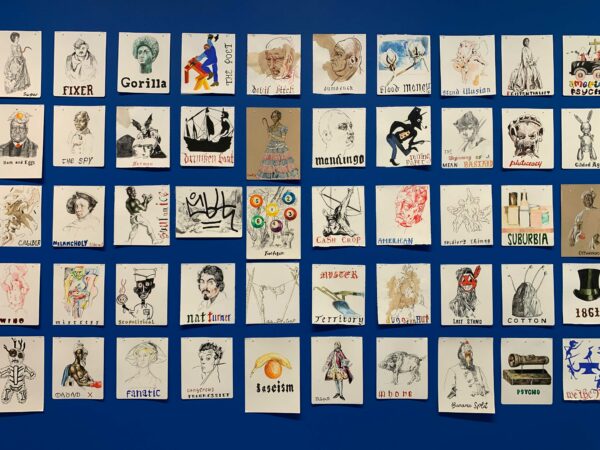

8 comments
Thank you for this deep dive into McGee’s show at Inman. There is a whole other beautifully lit room in the gallery of paintings by McGee that are totally different in style that are in short a bouquet for his mother, Gloria. They were created in the same period as the tarot cards and the four large watercolors of women, which may give the viewer even more food for thought re: this epic exhibit.
My favorite, aside from the exquisitely painted large ones, was Clarence Thomas with a fried egg on his head.
Agreed! David’s exquisite technique and thoughtful subject matter is a tour de force. A must see show that offers inspiration and insight!
Loooooove David’s work. It’s so nuanced and intentional it holds its own–in such a way that we can gush about it all day without demeaning the work of another Black artist.
I find your critique of Wiley in comparison to McGee confusing, because the latter is focused deeply on content/meaning, while the former is limited to artistic process. It would have been interesting to explore the conceptual meaning of Wiley’s work within this comparison.
An editorial note – The Wiley exhibition in Houston is titled An Archaeology of Silence.
Well researched article, and here are my comments.
3 things.
1) Both Artists are young, gifted and Black.
(playwright Lorraine Hansberry coined the phrase “young, gifted and black” in 1964, I use her coined phrasing here, and capitalize the ethnology for ‘Black’. This coinage is from a description from an NPR segment News and Notes on Painter Kehinde
Wiley aired June 1, 2005 By Roy Hurst
( https://www.npr.org/2005/06/01/4674694/painter-kehinde-wiley)
2) Both Artists paint life-like
and life-sized lives of people and creatures and situations with astute ability and acerbic beauty.
My take is this;
3) These two Artists are very different people, as people go, and especially very different painters.
I also appreciate the Exhibition being revisited for review after the opening Inman Gallery show review, as that review made, what I deem to be, a stellar observation and overview of the Gloria Paintings, which to date are my most favorite of Mr McGee’s paintings as they took many full circle investigations to arrive as mature and heartfelt works. The Tarot Cards, I believe, in turn, ushered (better yet, painted) David into his 60’th decade, as lived daily reminders of what it could possibly mean to be an American Artist, fiercely loyal to his family, his Art and acutely aware of the important responsibilities of an artist in relationship with his/her/their unique and public conversation with history.
Please pardon my love of expressing myself in ridiculously long sentences.
I remain humble and appreciative.
Hands down best show I saw this year. I especially loved the contrast of works in the smaller gallery. Nice to see artists thinking and making in different ways in the same show. Bravo David and Inman Gallery!
Yowza! Great writing that makes me wanna take a trip to Houston, frames McGee in the art canon.